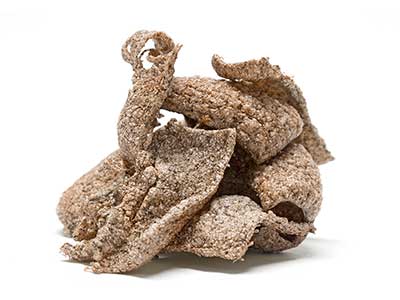December 15, 2014
Amuse-Bouche

biscuit salé de riz et nori
(nori-flavored rice crackers)
Many food items are intumescent. Add the right heat, and they swell and become less dense. The cooked and dried pasta I used in my macaroni and cheese presentation is an example of intumescence.
What causes the expansion is straight forward. When the pasta is cooked, cross-linked starch molecules trap water droplets. When it is then dehydrated, many of these water droplets gently evaporated and disappear. Even though the newly dried pasta is quite hard, there is still some water trapped in the starch. When the dehydrated pasta is quickly heated in the hot oil, the remaining water droplets rapidly convert from liquid to steam causing the stretching of the starch molecules and giving the bubbled, expanded appearance to the pasta. You can’t see the escaping gaseous water when the dehydrated pasta is cooked, but the effects are easily seen in the hot oil.
I thought that my dried pasta posting would be my only example of intumescence, but I was wrong. I was at a meeting in St. Helena (CA) in September and a former Charlie Trotter cook by the name of Hiroo Nagahara did a demonstration that included some nori-flavored rice crackers. My notes from his preparation description read: “Grind nori and rice powder. Make dough. Dry in 200°F oven. Fry.” Not a lot to work with but enough. There wasn’t enough information to duplicate Hiroo’s delicate rice crackers. There was enough information for me to take the concept and see what I could come up with.
In order to trap sufficient water so the crackers would swell when heated, I needed to do a little work with the rice starch. The inexpensive rice flour I use is simply ground raw rice. Uncooked, it is about eighty percent starch: I assume a combination of amylose and amylopectin. Both of these starches begin to gelatinize between 50 and 60 °C (122 and 140 °F). By the time they reach 80 °C (176 °F) the molecules will disassociate and begin to cross-link, thickening the solution, trapping water, and forming a gel. When the heated starches cool, the rate of gelling increases and the molecules retrograde into a more crystalline structure. Dehydrating the gel then drives off the water molecules not fully captured by the starch.
My resulting rice crackers had a decidedly darker color and stronger flavor than the prototype because I apparently used a larger concentration of nori. For a standalone amuse-bouche with only a couple of bites per serving, intense flavor is a must so I was satisfied with the ratio I used. Here’s what I did.
8 g (about 2 sheets)
nori (as for sushi)
50 g (1⁄4 c)
white rice flour
2 g (scant 1⁄4 t)
fine salt
225 ml (scant 1 c)
water
1. Using scissors, cut the nori into small strips. Place the strips in the bowl of a grinder along with part of the flour. Grind the nori into a fine powder. Finish by adding the remainder of the rice flour to the grinder so the two are mixed evenly.
2. Empty the contents of the grinder onto a large piece of paper. Sift through the flour, and remove any pieces of nori found.
3. Transfer the flours to a saucepan along with the salt and water. Whisk the mixture until smooth.
4. Set a silicone-rubber pan liner on a half sheet pan, and set aside.
5. Place the saucepan over medium to high heat. Slowly stir the mixture with a wooden spatula to keep the starch in suspension. When the bottom starts to thicken, increase your rate of stirring to rapid. When fully thickened, remove the saucepan from the heat, and give the mixture a few more stirs.
6. Using a small offset spatula, spread the thickened mixture into a thin layer on the prepared sheet pan. Make the layer no thicker that what it needs to be so none of the liner peeks through. No thicker. Using the edge of the spatula, score the layer of paste into 4- by 8-cm (1-1⁄2- by 3-in) rectangles.
7. Dry the paste rectangles in a 95 °C (200 °F) oven. Be sure that both sides of the rectangles, which will shrink, are dry. Pieces with see-through portions will cook up fine so don’t discard them. Store the dried paste pieces in an airtight container until needed.
8. For service, heat a couple of centimeters depth of oil in a saucepan until it reaches about 200 °C (400 °F). Play with the heat so that the crackers expand almost immediately after hitting the hot oil. If too hot, the crackers will rapidly brown, giving them a puke-brown color. If too cool, the crackers will just sit and float and burn. Work quickly. Drain the crackers on a tea towel. Serve warm.
9. Note: I assume 2 crackers per serving.
10. Yield: Around 40 crackers.
© 2014 Peter Hertzmann. All rights reserved.
